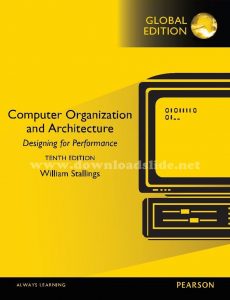 |
| Computer Organization and Architecture 10th edition by Stallings (Global Edition) |
Computer Organization and Architecture 10th Edition by William Stallings
Computer Organization and Architecture is a comprehensive textbook that covers all aspects of computer design, from the fundamental concepts of computer structure and function to the latest advances in computer architecture. The book is written in a clear and concise style, and it is well-organized and easy to follow.
The book is divided into five parts:
- Part 1: Introduction
- Part 2: The Central Processing Unit
- Part 3: Memory and I/O
- Part 4: Parallel Processing
- Part 5: Advanced Topics
Part 1 introduces the basic concepts of computer organization and architecture, including the structure and function of a computer system, the history of computers, and the evolution of the Intel x86 architecture. It also discusses embedded systems, Arm architecture, and cloud computing.
Part 2 covers the central processing unit (CPU), which is the heart of a computer system. It discusses the different components of the CPU, such as the arithmetic logic unit (ALU), the control unit, and the registers. It also discusses instruction sets, instruction formats, and instruction execution.
Part 3 covers memory and input/output (I/O). It discusses the different types of memory, such as main memory, cache memory, and virtual memory. It also discusses the different types of I/O devices and how they are connected to the CPU.
Part 4 covers parallel processing, which is a technique for using multiple processors to execute a program simultaneously. It discusses the different types of parallel processing systems, such as shared-memory systems, distributed-memory systems, and hybrid systems.
Part 5 covers advanced topics in computer organization and architecture, such as pipelining, multithreading, and superscalar processors. It also discusses the emerging trends in computer architecture, such as quantum computing and neuromorphic computing.
Computer Organization and Architecture is an excellent textbook for students who are interested in learning about the design and architecture of computers. It is also a valuable resource for computer professionals who want to stay up-to-date on the latest advances in computer architecture.
Here is a summary of some of the key topics covered in the book:
- Computer structure and function: The book provides a detailed overview of the structure and function of a computer system, including the CPU, memory, I/O devices, and system software.
- Instruction sets and instruction execution: The book discusses the different types of instruction sets and how instructions are executed by the CPU.
- Memory and I/O: The book covers the different types of memory and I/O devices, and how they are connected to the CPU.
- Parallel processing: The book discusses the different types of parallel processing systems and how they are used to improve performance.
- Advanced topics: The book also covers advanced topics such as pipelining, multithreading, and superscalar processors, as well as emerging trends in computer architecture.
Overall, Computer Organization and Architecture is a comprehensive and well-written textbook that covers all aspects of computer design and architecture. It is an excellent resource for students and professionals alike.
